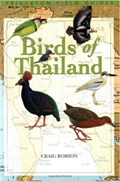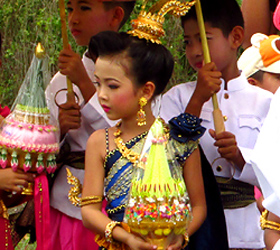| Photography
Day Tour Around Petchaburi, 25th May 2013 |
| |
|
|
|
Introduction
Michael Lang contacted me as he was visiting Thailand on a photography
assignment to obtain professional level shots of Thai food and its
ingredients. He also explained that he enjoyed bird photography
very much and would like to spend a day out of Bangkok to pursue
this. I informed him that at the end of May rice fields around Petchaburi
would probably provide him with the highest number of good photographic
opportunities of a good number of interesting species. |
While
most bird watchers visit Thailand between the months of November
and March, I explained to Michael that in May there were a number
of species which were seen at their best whilst breeding.
Getting There
I used a Toyota Vigo for this day trip. More or less any vehicle
could have been used but I took this as I thought we may go
down some muddy dirt tracks that a saloon car would not deal
with very well considering that this was the start of the rainy
season.
We took the expressway out of Bangkok towards Rama II road and
continued along this highway until it merged into the Petkasem
highway which is the main route to southern Thailand. A few
kilometres before arriving at the town of Petchaburi there is
a bridge over the highway which carries vehicular traffic and
we took the left hand turning at this bridge to enter the rice
fields.
|
|
|
|
From
here to Laem Pak Bia we followed signs to Ban Laem, Ban Pak Thale
and then Had Chao Samran, all are signposted in English along the
way.
Accommodation
As this was a day trip from Bangkok we did not require any local accommodation.
However, if people are visiting this area as part of a longer tour
there are a number of places to stay in Petchaburi and at Hat Chao
Samran. |
Food
There are only a few very rudimentary places to eat in the rice fields
so we drove to Hat Chao Samran where there are several nice seafood
restaurants on the beach. |
Notes
on Finding Birds
The open nature of the rice fields always makes finding birds fairly
easy, particularly if one knows where each species tends to be;
in particular, I knew where some nesting colonies of weavers were
which made finding them extremely simple.
In the salt
farms and surrounding scrubby areas the wind and rain from a passing
storm made locating birds very tricky as they were being blown all
over the place and sheltering. We still managed to get some interesting
shots, though, particularly of birds in flight. |
Field
Guides
1. A
Field Guide to the Birds of South East Asia by Craig Robson
2. Birds
of Thailand - Thai language field guide by various contributors |
Birding
Highlights
Tung Bang Jak: Asian Golden Weaver, Watercock,
Indian Pond Heron, Javan Pond Heron, Streaked Weaver, Baya Weaver,
Black Bittern
Wat Komnaram: Oriental Pratincole
Laem Pak Bia: Painted Stork, Indochinese Bushlark |
Account
Of The Day
Tung
Bang Jak
As soon as we turned off the Petkasem highway and entered the rice
fields we started to see birds close enough to photograph. However,
the road can be a little busy right near the highway so I drove
some distance to give a long line of sight; it is important to think
about safety here as trucks often go along this road too fast.
The first birds we stopped for was a group of Red-wattled Lapwings.
These are very common, even annoying, birds but we found a pair
with a fledged chick which was interesting to get some nice shots
of, particularly when it began to stretch; an Asian Pied Myna came
to show off in front of us at this stop too. |
Although
the rice fields contain a higher number of species in the dry
season, visitors at that time will not be able to see the wonderful
spectacle that the weavers create in the breeding season. All
three Thai species of weavers can be found here and they usually
begin coming into breeding plumage around the beginning of March,
but sometimes a little earlier. However, in May they are all
well into rearing young and I knew where we could find nest
sites of Asian Golden Weaver, Streaked Weaver and Baya Weaver.
>A very co-operative little colony of Asian Golden Weavers had
constructed their nests in a small bush right next to the road
so we stopped and enjoyed watching them go about their business
and taking photos of them. Some males were weaving while females
were feeding young in the nest - we could hear them calling
to their parents for food. As you can see from the photo on
the right, the male of this species is fantastic, for me it
is one of Thailand's best birds, and it is a shame that most
visitors only get to see it in non-breeding plumage.
Some Streaked Weavers were busy on the other side of the road
but the light was far too harsh for photography in that spot
- so often getting nice images depends on finding good light.
A little further down the road we found some more Asian Golden
Weavers posing nicely in some Typha, although we already
had great shots of this species it was hard to pass up the opportunity
to photograph this little jewel. As we were doing this, some
Streaked Weavers arrived and took the place of the Asian Golden
Weavers; this time they were on the "right" side of
the road and Michael was able to take some lovely pictures of
them perched in the Typha.
Often on bird watching trip things can seem a bit of a rush,
moving around trying to see as many species as possible but
on this occasion we spent a long time getting a variety of shots
of these birds and, of course, it takes time to get the best
photographs. |
|
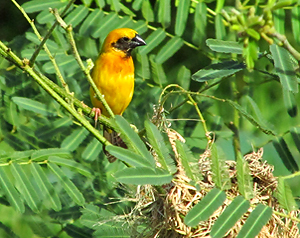
Male Asian Golden Weaver & Nest
(Photo by Nick
Upton) |
| |
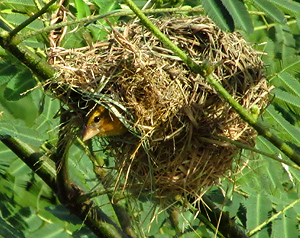
Female Asian
Golden Weaver & Nest
(Photo by Nick
Upton) |
|
| Having
got very many weaver pictures we drove a short distance into some
fields to get a better angle on a different area full of water birds.
Along here we found a variety of commoner species including Javan
Pond Heron, Asian Openbill, Common Myna and a few others. Asian Openbill
is always in large numbers in this area and Michael was able to get
lots of nice images of these birds, although we never did manage to
get that shot of one with a snail in its bill! |
Our
exploratory drive into an area that I do not usually frequent
resulted in a nice stop at a pool which had a number of breeding
plumage Javan Pond Herons which are really beautiful birds at
this time of year in contrast to their dull non-breeding plumage.
This species is very common in the area and was expected; what
was not so expected was an Indian Pond Heron also in breeding
plumage - a species that is very uncommon in Thailand. Although
Chinese Pond Heron is a common migrant to Thailand I did not
expect to see any at the end of May, however, one bird in its
chestnut-headed breeding colours was in the same pool, completing
a hat-trick of pond herons.
Here we also took the opportunity to photograph some White-vented
Mynas that were feeding and squabbling in the recently planted
rice. The bright green rice plants made for a nice background
and, as is so often the case, while we were appreciating these
birds something else of interest presented itself; a pair of
Asian Pied Mynas, perched on a fallen banana plant, with the
male passing food to the female which Michael managed to get
some nice photos of.
We drove towards some resting cattle but failed to get any pictures
of the mynas sitting on these animals so we turned around and
headed back out onto the main road through the fields. Half
way back I noticed a Plain Prinia calling from some dead twigs.
This is a bird which is as plain as its name suggests but with
a lovely green background, good light and clear air it made
a very nice photograph.
We made some more attempts to get shots of Openbills eating
snails but each time we stopped the storks would slink off to
the other side of the field, giving us only a view of their
backs and no snails!
The fields here are always full of birds and every time we stopped
something gave us a chance of photographing it. While I stopped
to take a picture of a red flowering tree we noticed a couple
of Scaly-breasted Munias sitting in the rice, once again, common
birds but a very pretty sight. |
|
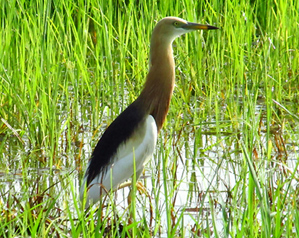
Javan Pond Heron
(Photo by Nick
Upton) |
| |
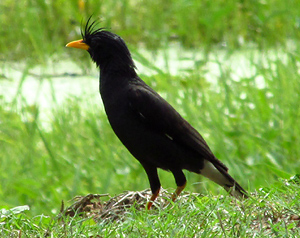
White-vented
Myna
(Photo by Nick
Upton) |
|
| Having
enjoyed these common birds it was time to go and find our third species
of weaver; Baya Weaver. In fact this species is by far the most common
of the three weavers and we had driven past several colonies which
were too high, too far away or in poor light as I knew where there
was an impressive colony that we could get very close to and that
would have good light on the nests. |
An
amazing collection of these bottle-like nests had been constructed
in a small tree right in front of someone's house and we stood
on the road just a few feet away from the busy activity of the
birds popping in and out of the nests and making additions and
repairs to them. There were so many nests that the branches
of the tree were hanging down with the weight!
I see this spectacle every year but I am always amazed when
I see these incredible nests and the activity of the males calling
the females while hanging on their partially constructed nests.
They made a wonderful subject for photography and as we were
taking our last shots of them a Pied Fantail turned up to pose
for Michael.
Further along the road we found a male Plain-backed Sparrow
in a tree. This is a far more beautiful bird than its name suggests
and although it was a little backlit it was worth a few snaps,
particularly as most sightings are of it is sitting on wires
which does not make for a nice picture. |
|
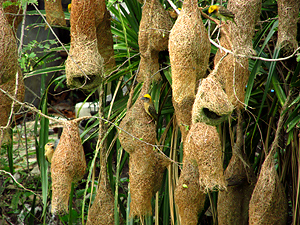
Baya Weaver Colony
(Photo by Nick
Upton) |
|
| Having
obtained great photos of all three weavers I decided it was time to
head to a nearby fish pond where we would find some different species.
In the fishpond were a variety of waterbirds including Little Cormorant,
Little Grebe, Bronze-winged Jacana and Purple Heron but, unfortunately,
they were all too far away for good shots, even with the 500mm lens
that Michael was using. While checking the area for photographable
species I came across 2 Black-browed Reed Warblers, which should have
left for more northern countries by this time, a pair of Yellow-vented
Bulbuls and a male Watercock. |
At
the same time Michael had done a bit of scouting himself and
found a nice Common Iora only a few feet away in a low bush;
another under-rated bird due to how common it is but if one
takes the time to look at it properly it is a very beautiful
little bird and this one performed well.
A Long-tailed Shrike was next, an undoubtedly smart creature
which Michael managed one shot of but it was another one of
those less than satisfying shots of a bird on a wire! However,
some very smart Eastern Cattle Egrets and Javan Pond Herons
in breeding plumage were nice in a recently ploughed field.
Another quick stop here also revealed a calling Yellow-bellied
Prinia at the top of a bare tree. He was very agitated and called
aggressively from his perch for a few minutes giving us plenty
of opportunity to take his portrait.
Lunch was starting to call us but this White-breasted Waterhen
with its two chicks, in a roadside ditch, distracted us for
a few minutes before they crept away into the undergrowth. |
|
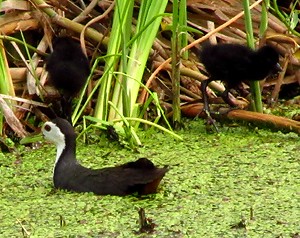
White-breasted Waterhen
(Photo by Nick
Upton) |
|
| We
drove towards Laem Pak Bia district where I knew a nice seafood restaurant
on the beach, via Ban Laem and Pak Thale. The route took us through
the salt pans where Spoon-billed Sandpiper winters but late May is
too late for this species and all other migrant waders so instead
we made one more pre lunch stop at Wat Komanaram. |
Wat
Komnaram
Wat Komnaram has a large piece of open land in front
of it which gets flooded for much of the year but in February
to June it is bone dry and has large areas of bare soil - just
the sort of habitat that oriental Pratincoles like to nest it.
Oriental Pratincoles are unusual in that they arrive in Thailand
in February and stay through the wet season, nesting on the
ground. I knew there were lots of them at Wat Komnaram but did
not expect us to be so lucky as we were. I thought that we would
have to stalk the birds a little to get close enough to photograph
them but one bird sat out in the open and we were able to drive
really close to it and sit in our mobile hide and get some really
nice shots of the bird.
Despite a lot of straining of the eys, singing Oriental Skylarks
never gave us any opportunity to see anything more than a fluttering
dot in the sky, unfortunately. |
|
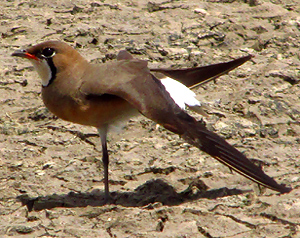
Oriental Pratincole
(Photo by Nick
Upton) |
|
| The
Sites Visited Around Petchaburi |
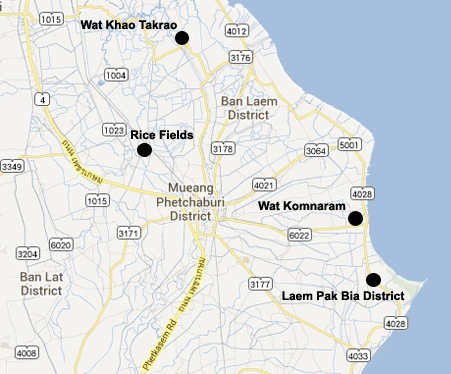 |
|
The
sites that we visited on this day trip are all within
a short drive of the provincial capital of Petchaburi,
an hour and a half from Bangkok.
The
rice fields can be reached from Petchaburi town within
minutes and these lead to Wat Khao Takrao. Although
there are a maze of small roads in this area, Ban Laem
is signposted from most places so by following signs
to this spot, signs to the next location will appear.
Laem
Pak Bia is most easily reached by following signposts
from the Petkasem highway, just south of Petchaburi,
to Had Chao Samran and then turning left at the cross
roads a few hundred metres before reaching the sea.
Wat Komnaram is further along this coast road in the
village of Bang Kaew; turn left just after the fuel
station and you will see a large temple complex across
a big field. |
|
|
Laem
Pak Bia
After lunch I took Michael to a few spots in the Laem Pak Bia area
that I thought would allow us to get close to some different species
of birds and the first of these stops was at the small dump on the
way to the abandoned building (see Laem
Pak Bia page for details). This is a good spot for a few birds
and although a single Green Bee-eater did not perform for us a foraging
Indochinese Bushlark did. Some mynas in the filthy rubbish dump did
not excite us so we moved on to another area. |
This
next stop was some wetland and scrubby areas that lead to a
temple and it always contains a lot of birds. As we arrived
we noticed a group of about 30 Painted Storks which were frustratingly
too far away for photographs. Also present were more Oriental
Pratincoles, Lesser Whistling Duck and Little Grebe. Some Chestnut
Munias flew away before we could get our cameras prepared but
this very smart Eastern Great Egret in full breeding splendour
occupied us for a while as it stalked fish in the shallow water
alongside Eastern Cattle Egrets and Javan Pond Herons.
I don't often get to see these egrets in quite such good condition;
this one has a very blue/green bare facial skin patch, nice
plumes and deep red legs.
We also managed to get some nice shots of Peaceful Dove here,
the birds were foraging amongst some grass which made nicer
pictures than the ones of them posing on the road and on wires
that we had got earlier in the day.
Storm clouds began to gather and the wind which comes before
the rain began to blow birds around making it hard to get anywhere
near them, particularly smaller species. With this we attempted
to head north along the coast road and away from the bad weather.
Unfortunately, this did not really work out as the storm was
heading north and making a stop to photograph a parade of local
people taking two young men to the temple to become monks meant
that the rain was imminent.
As we made our way towards the King's Project we noticed a Great
Egret flying into the wind and making no progress at all. It
was flying at the same speed as the wind was blowing making
it appear to be stopped still in mid air!
We made our way into the King's Project just before the heavens
opened. |
|
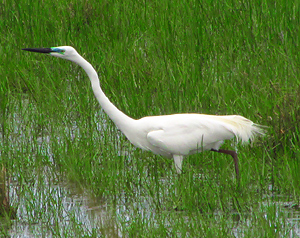
Eastern Great Egret
(Photo by Nick
Upton) |
| |
 |
|
Bird
Watching & Photography Trips In Thailand:
The dry season (November to April)
and early wet season |
(May,
June & July) are good times to visit Thailand
for bird watching and photography; abundance is
high in the dry season but nesting activity is in
the early wet season.
Contact me to arrange a trip and/or to discuss the
best birdwatching options for you: nickupton@thaibirding.com |
|
|
|
| Luckily
for us the rain did not last very long at all, we must have been on
the very edge of the storm, although we were left with some very breezy
weather and overcast skies. |
| The
Camera I Used To Take The Photographs On This Page
|
 |
|
All
the photographs displayed in this report were taken by
me, on this day trip, using a simple compact digital camera;
Canon
SX160 IS.
Michael was using a very expensive set up, a Nikon body
with 500mm lens, which meant that where I was able to
get nice photos to use at small sizes here, he was able
to obtain extremely beautiful and clear images.
I just use a simple camera on these trips because I am
too busy finding birds for the bird watchers and photographers
who accompany me and I do not want a bulky piece of equipment
hampering me in this, nor do I want those with me to feel
that my priority is taking my own photographs; I only
start using my camera after everyone else has spotted
the bird and is able to get the photos they want. |
Simple digital cameras have advanced a lot and it is possible
to take internet quality photographs of birds with most
cameras that cost less than $200. However, digital cameras
are not miracle-workers and it does takes some practice
and the right light conditions to get the best out of
these cheap cameras and one needs to get fairly close
to get a decent shot. Most cameras around the price of
this one allow for manual setting of ISO, aperture and
shutter speed, making it easier to get good shots. |
|
|
| Despite
the grey skies we spent some time in the King's Project area. This
is a great spot for using the vehicle to get really close to the birds
and we spent time getting shots of some of the commoner resident waterbirds
here. As well as resident species we once again found a few straggling
migrants too; Pacific Golden Plover, Marsh Sandpiper and Whiskered
Tern. |
Once
again a Javan Pond Heron in its breeding finery distracted us.
It was just a few feet away from us but it was always just partially
obscured by some pieces of grass no matter how long we waited
or where we repositioned ourselves; still, its colours stood
out nicely from the green background.
It turned out that the blustery weather conditions presented
Michael with quite a few opportunities to get some shots of
birds in flight as they battled against the conditions; Little
Tern, Whiskered Tern, Black-winged Stilt and Red-wattled Lapwing
all performed in this way and many Indian Cormorants on the
water and sitting on posts were another distraction for us.
Up to this point we had not paid much attention to one of the
commonest birds around - Black-winged Stilt. Here a group of
them were busy bathing quite close to the car so we got some
nice images of them with a nice background. Although it is easy
to get clear shots of this species I find it hard to actually
get nice photos as it is quite ungainly and often has ugly backgrounds
due to its habitat choice.
After the King's Project area we drove along the coast road
and headed inland a little towards Wat Khao Takrao stopping
to take some photos of people working on the salt farms and
some colourful boats in a little boat yard.
Wat Khao Takrao
At the temple itself Michael wanted to get some
shots of monkeys and at Wat Khao Takrao there are always a lot
of Long-tailed Macaques and this day was no exception with hoards
of them being fed peanuts by some of the local people. |
|
|
| |
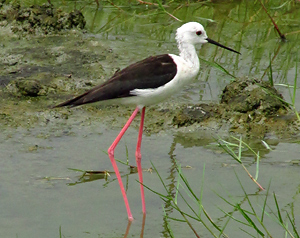
Black-winged Stilt
(Photo by Nick
Upton) |
|
Pools
in this area usually hold Painted Storks and I was keen for us to
get some pictures of these, but for some reason there were none on
this occasion proving that nothing is guaranteed in bird watching.
We did come across a very nice Collared Kingfisher, though, and a
Ruddy-breasted Crake. Large numbers of egrets and pond herons in a
muddy pool contained a few Intermediate Egrets but in the grey light
conditions they were too far away to ever make a decent photo so we
moved on.
Heading back into the rice fields the weather began to spoil things
once again with spots of rain, it looked like we had run into the
edge of that storm again. We got some nice images of the rice fields
with mountains and storm clouds in the distance before we decided
that it was time to head back to Bangkok anyway. |
| Nick
Upton (nickupton@thaibirding.com) |
|
|
| Species
list with notes |
Tung
Bang Jak: TBJ
Laem Pak Bia: LPB
|
Wat
Komnaram: WKN
Wat Khao Takrao: WKT |
1.
Lesser Whistling Duck: a5 at LPB.
2. Collared Kingfisher: 1
at WKT.
3. Green Bee-eater: A few
at LPB.
4. Asian Koel:
1 at TBJ.
5. Greater Coucal: A few
at TBJ.
6. Asian Palm Swift: Everywhere.
7. Germain's Swiftlet: Lots
of LPB & WKT.
8. Feral Pigeon
9. Spotted Dove: Everywhere.
10. Red Collared Dove: Everywhere.
11. Peaceful Dove: Everywhere.
12. Little Grebe: A few at LPB.
13. White-brested Waterhen:
TBJ.
14. Ruddy-breasted Crake:
1 at WKT.
15. Watercock: 1 at TBJ.
16. Marsh Sandpiper: 1 at
King's Project, LPB.
17. Bronze-winged Jacana:
A few at TBJ.
18. Black-winged Stilt:
Everywhere.
19. Oriental Pratincole:
Many at WKN.
20. Pacific Golden Plover:
1 at King's Project, LPB.
21. Red-wattled Lapwing: Everywhere.
22. Little Tern: A few at
LPB.
23. Whiskered Tern: A few at LPB.
24. Black-shouldered Kite:1
at TBJ.
25. Brahminy Kite: 1 at TBJ.
26. Little Cormorant: Everywhere.
27. Indian Cormorant: Many
at LPB.
28. Little Egret: Everywhere.
29. Eastern Great Egret: Everywhere.
30. Eastern Cattle Egret:Many
at TBJ & LPB.
31. Intermediate Egret: A
few at WKT.
32. Purple Heron: A few at
LPB. |
33. Black-crowned Night Heron:
1 at LPB.
34. Indian Pond Heron: 1
at TBJ.
35. Chinese Pond Heron: 1
at TBJ.
36. Javan Pond Heron: Everywhere.
37. Black Bittern: 1 at TBJ.
38. Painted Stork: a30 at
LPB.
39. Asian Openbill: Many
at TBJ.
40. Long-tailed Shrike: 1
at TBJ.
41. Eastern Jungle Crow: A
few at TBJ.
42. Pied Fantail: Everywhere.
43. Black Drongo: A few at
TBJ.
44. Common Iora: 1 at TBJ.
45. Oriental Magpie Robin:
Everywhere.
46. Asian Pied Starling:
Everywhere.
47. Common Myna: Everywhere.
48. White-vented Myna: Everywhere.
49. Ashy Woodswallow: A few
at TBJ.
50. Yellow-vented Bulbul:
2 at TBJ.
51. Streak-eared Bulbul:
A few at TBJ & LPB.
52. Yellow-bellied Prinia:
1 at TBJ.
53. Plain Prinia: A few at
TBJ & LPB.
54. Black-browed Reed Warbler:
2 at TBJ.
55. Oriental Reed Warbler:
1 at TBJ.
56. Indochinese Bushlark:
1 at LPB.
57. Oriental Skylark: 1 at
WKN.
58. House Sparrow:
A few at LPB.
59. Plain-backed Sparrow:
1 at TBJ.
60. Eurasian Tree Sparrow:
Everywhere.
61. Streaked Weaver:
A few at TBJ.
62. Baya Weaver: Many at
TBJ.
63. Asian Golden Weaver:
Many at TBJ.
64. Scaly-breasted Munia: A
few at TBJ. |
| Nick
Upton can be contacted at nickupton@thaibirding.com |
| If
you are interested in arranging a bird watching tour you can see some
suggested itineraries here - Birdwatching
Trips - and you can contact me at the above email address to discuss
the best options. |
 |
| |
|
|
|
|
|

